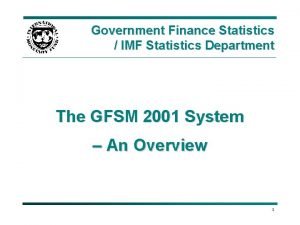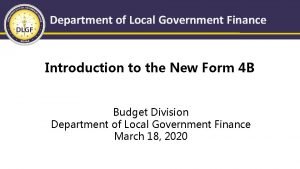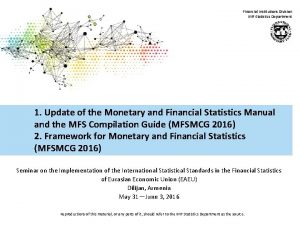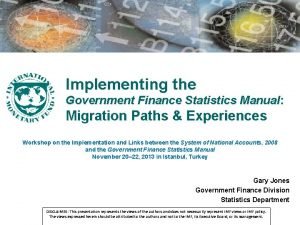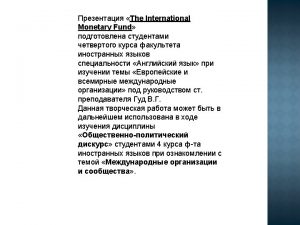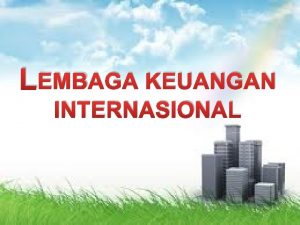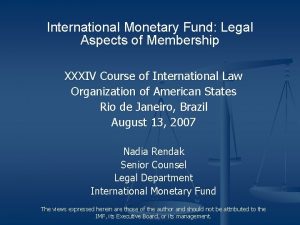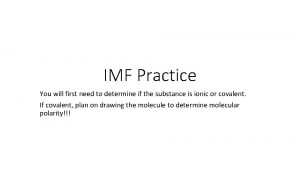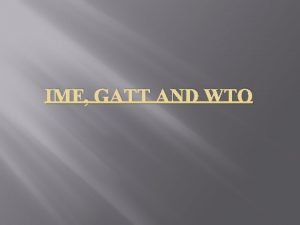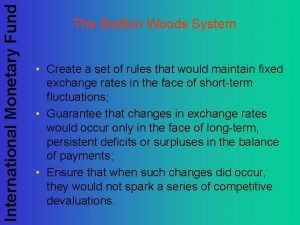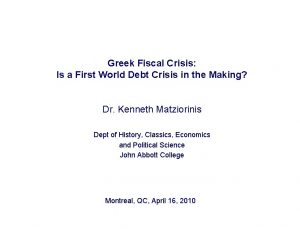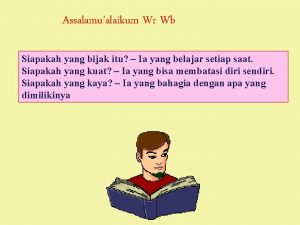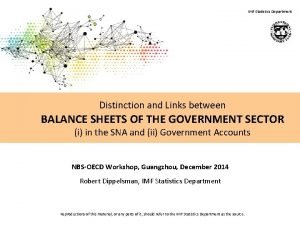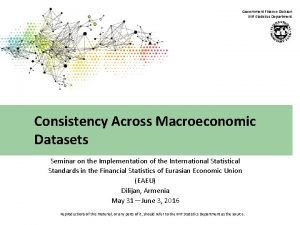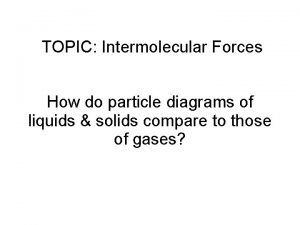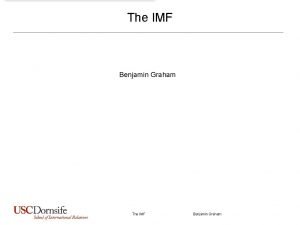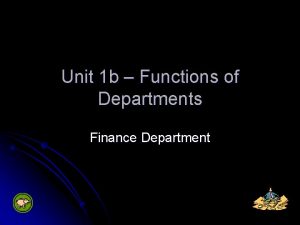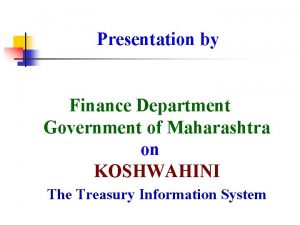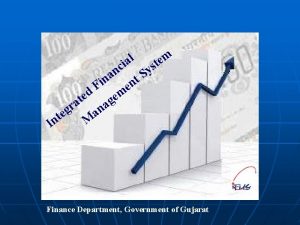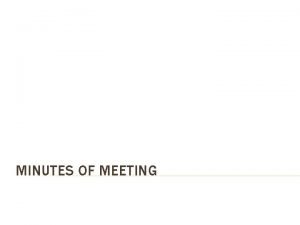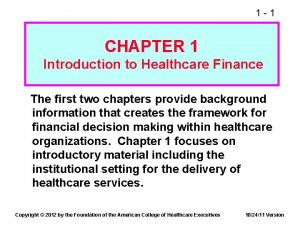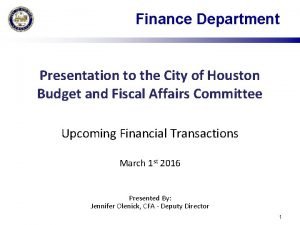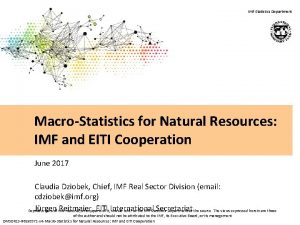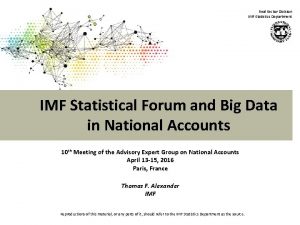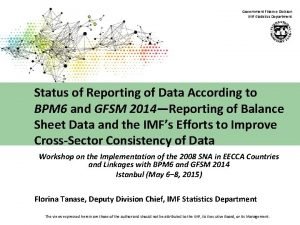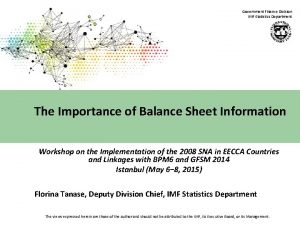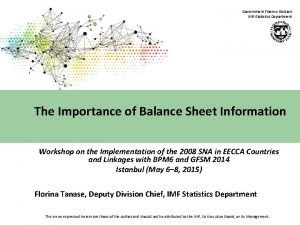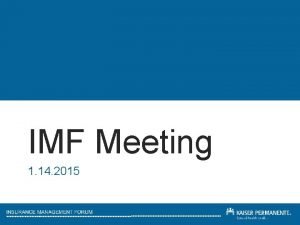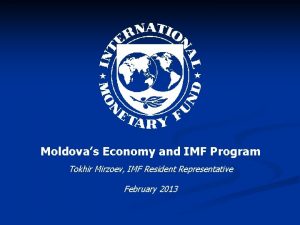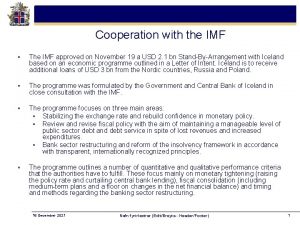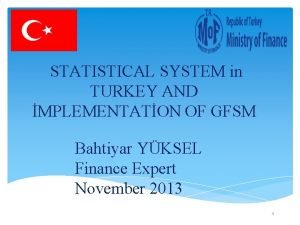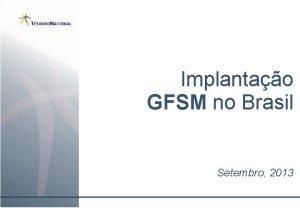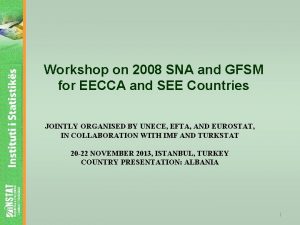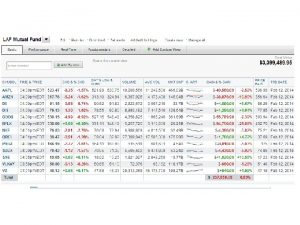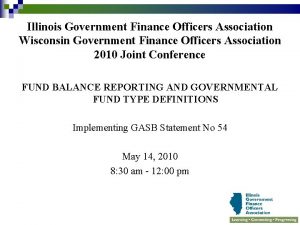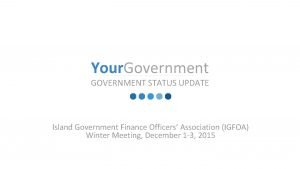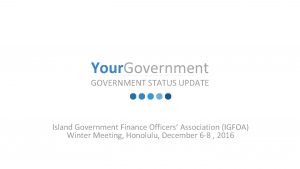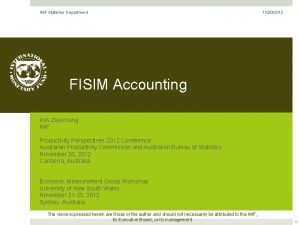Government Finance Statistics IMF Statistics Department The GFSM



































- Slides: 35

Government Finance Statistics / IMF Statistics Department The GFSM 2001 System – An Overview 1

Contents § Why revise the GFSM 1986? § Objectives of the GFSM 2001 § The GFSM 2001 system • Coverage • Definitions • Accounting rules • Analytic framework • Statements • Balances • Implementation 2

Why a revision of the GFS Manual 1986? 1/4 § Conceptual framework is ± 20 years old § Cash-based recording, thus ignored inter alia: • arrears • interest on discounted bonds • in kind transactions • consumption of fixed capital § Emphasis was on a single deficit measure • revenue plus grants minus expenditure minus net lending = deficit/surplus 3

Why a revision of the GFS Manual 1986? 2/4 § Revenue and grants were defined as: • All nonrepayable receipts § Expenditure was defined as: • All nonrepayable payments § Lending minus repayments (“net lending”): • Transactions in financial claims acquired for purposes of public policy • Repayable transactions, included above the line with nonrepayable transactions 4

Why a revision of the GFS Manual 1986? 3/4 § Financing was defined as: • Government liabilities (“net borrowing”) and changes in cash & deposits (financial asset) § Focus of cash-based system was on govt’s financing constraint • Liquidity constraint viewed as most binding priority of govt. 5

Why a revision of the GFS Manual 1986? 4/4 § Recently new topics have assumed importance for fiscal analysis, e. g. , • arrears, transactions in kind, balance sheet items (stocks, net worth), sustainability of fiscal policy • world-wide shift toward resource-based accounting, because of dissatisfaction with cashbased accounting § Other related statistics Manuals have been revised, e. g. , SNA, BOP 6

Objectives of the GFS Manual 2001 1/2 § A system to address evolving changes: • in the way countries maintain their government accounts, and • analyze data in these accounts § A manual that: • serves specialized needs of compilers, analysts, and policy makers, and • subject to those needs, a manual that is harmonized as fully as possible with the 1993 SNA 7

Objectives of the GFS Manual 2001 2/2 § To achieve analytic objectives, the new GFS system should generate data that: • are directly linked to other macroeconomic statistical systems • enable analysts to do assessments of financial soundness of government in ways applied to other organizations in economy 8

Coverage of the GFSM 2001 System General government Public non-financial corporations Non-financial public sector Public financial corporations Non-monetary public sector Public sector – Nonmonetary – Monetary (incl. the central bank) 9

The GFSM 2001 System (1/3) § Balance sheet approach • stock of assets, liabilities, and net worth (assets minus liabilities) § Measures of revenue and expense • revenue – transactions that increase net worth • exclude sales of assets (which are exchanges of one asset for another) • expense – transactions that reduce net worth • exclude acquisition of assets 10

The GFSM 2001 System (2/3) § Transactions in nonfinancial assets • net acquisition of nonfinancial assets – acquisition – disposal • consumption of fixed capital § Financing (transactions in financial assets and liabilities) • identify financial assets and liabilities separately (by residency, instrument, sector) – net acquisition of financial assets – net incurrence of liabilities 11

The GFSM 2001 System (3/3) § Integrated system • Full integration of flows and stocks (operating statements and balance sheets) • Basic principle of GFSM 2001 system: opening balance sheet value + transactions + other economic flows = closing balance sheet value 12

FLOWS TRANSACTIONS Revenue minus OPENING BALANCE SHEET Nonfinancial Assets Expense = NET OPERATING BALANCE minus Nonfinancial Assets OTHER ECONOMIC FLOWS Holding Gains Other Changes in & Losses the Volume of Assets CLOSING BALANCE SHEET Nonfinancial Assets Financial Assets Liabilities = NET LENDING/ BORROWING Financial Assets • cash • other financial assets minus Liabilities Net Worth 13 Changes in Net Worth

Accounting Rules (1/3) § Accrual-based recording • when transaction takes place – – income is earned resources are used liabilities are incurred assets are acquired • it is a timing and data coverage question § Double-entry accounting 14

Accounting Rules (2/3) § Time of Recording • Flows are recorded when: – economic benefits associated with the events have flowed to or from the unit involved, or – it is probable that future benefits will flow to or from the unit, and – the monetary value of the events can be reliably measured § Valuation • All flows and stocks are valued at current market prices 15

Accounting Rules (3/3) § Netting • Generally, flows and stocks are recorded on a gross basis – For analytic presentations, the net acquisition of assets or net incurrence of liabilities may be used – Revenue categories are presented net of refunds – Expense categories are presented net of erroneous and/or unauthorized transactions § Consolidation • In GFS, data presented for a group of units are consolidated 16

GFSM 2001 Statements § Four statements: • Statement of Government Operations • Statement of Other Economic Flows • Balance Sheet • Statement of Sources and Uses of Cash 17

The Statement of Government Operations 1/6 § Summarizes government’s transactions in a given accounting period § Transactions are classified according to whether they: • increase net worth (revenue) • decrease net worth (expense) • change the stock of a nonfinancial asset (capital asset) • change the stock of a financial asset or liability (financing) 18

The Statement of Government Operations 2/6 Revenue - Expense = Net operating balance (gross operating balance) - Transactions in nonfinancial assets = Net lending/borrowing - Transactions in financial assets Financing + Transactions in Liabilities = zero (because of double-entry recording) 19

The Statement of Government Operations 3/6 § Revenue • Taxes • Social Contributions • Grants • Other revenue 20

The Statement of Government Operations 4/6 § Expense • Compensation of employees • Use of goods and services • Consumption of fixed capital • Interest • Subsidies • Grants • Social benefits Transfers • Other expense 21

The Statement of Government Operations 5/6 § Transactions in nonfinancial assets • Fixed assets * • Inventories (net change) • Valuables • Nonproduced assets * * Minus consumption of fixed capital 22

The Statement of Government Operations 6/6 § Financing • Transactions in (all) financial assets and liabilities • Multiple ways to classify: – by residency of counter party (domestic, foreign) – by type of financial instrument (securities other than shares, loans, shares and other equity, etc. ) – by “sector” of counter party (general government, central bank, depository corporations, etc. ) 23

Statement of Other Economic Flows 1/2 § Shows influences on govt’s financial position in accounting period from flows other than transactions, i. e. • Holding gains in assets & liabilities (revaluations) – Changes in the price of the asset or liability • Other volume changes in assets and liabilities – exceptional or unexpected events (e. g. , floods, earthquakes, wars, etc. ) – normal events (e. g. , discovery of subsoil asset, registration of patent) – reclassifications (e. g. , unit from central to local govt) 24

Statement of Other Economic Flows 2/2 Changes in nonfinancial assets Holding gains Other volume changes + Changes in liabilities Holding gains Other volume changes = Changes in net worth from other economic flows 25

Balance Sheet 1/2 § Shows the stocks of assets, liabilities and net worth at beginning and end of accounting period • Economic assets are recorded in GFS, i. e. , owners of assets can: – enforce ownership rights – derive economic benefits • Valued at current market value • Assets by type of asset • Liabilities by type of instrument 26

Balance Sheet 2/2 § Nonfinancial assets § Financial assets § Liabilities § Net worth(t) {= Net worth(t-1) + changes in net worth due to transactions [net operating balance](t) + changes in net worth due to other economic flows(t)} 27

Statement of Sources and Uses of Cash 1/2 § Shows the total amount of cash generated or absorbed by government through • current operations • transactions in nonfinancial assets • transactions in financial assets and liabilities (other than cash itself) § Net change in government’s overall cash position is sum of the net cash received from all the above 28

Statement of Sources and Uses of Cash (Shortened Version) 2/2 Cash receipts from government operating activities − Cash payments for government operating activities = Net cash inflow from operating activities − Net cash outflow from investments in NFAs = Cash surplus/deficit + Net cash inflow from financial operations other than cash: Net acquisition of financial assets other than cash Net incurrence of liabilities = Net change in stock of cash 29

STATEMENT OF GOVT. OPERATIONS VS. CASH FLOW STATEMENT Statement of Government Operations Revenue minus Statement of Sources & Uses of Cash inflows and outflows from transactions: • Operating activities Expense = NET OPERATING BALANCE minus Nonfinancial Assets • Purchases & sales of nonfin. assets = NET LENDING/ BORROWING Financial Assets • cash • other financial assets minus Liabilities • Financing activities = Net change in the stock of cash 30

Core Balances of the GFSM 2001 System § Multiple balancing items for transactions: • Net operating balance – Balance of transactions affecting net worth – Closely related to 1993 SNA government saving • Net lending/borrowing – Net operating balance minus transactions in NFAs • Cash surplus/deficit – Net cash inflow from operating activities minus net cash outflow from investments in NFAs 31

Other Analytic Measures § Some other analytic measures for fiscal policy (see Box 4. 1 in GFSM 2001) • Overall fiscal balance – Net lending/borrowing minus acquisition of financial assets for policy purposes • Overall primary balance – Overall fiscal balance plus net interest expense • Net worth – Total stock of assets minus liabilities • Net financial worth – Total stock of financial assets minus liabilities 32

Implementation of GFSM 2001 (1/2) § It is recognized that full implementation of the new GFS system is a long-term activity § Priorities can only be established by each country taking into account their situation, including available resources 33

Implementation of GFSM 2001 (2/2) § Nonetheless, countries are encouraged to develop a migration path towards the new system. § It is likely that this will include, over time: • improving existing cash-based data systems • adopting the new classification structure • making adjustments to existing data for serious deficiencies • developing balance sheet information 34

Hot Topics § Coverage § Bond Indexation § Debt § Public-Private Partnerships and Leasing Arrangements § Headline Fiscal Policy Indicators 35
 Gfsm 2001
Gfsm 2001 Department of local government finance
Department of local government finance Imf financial statistics
Imf financial statistics What is financial assets?
What is financial assets? Government finance statistics manual
Government finance statistics manual Roles of imf
Roles of imf Imf adalah
Imf adalah Imf chem
Imf chem Difference between imf and world bank
Difference between imf and world bank Materi tentang lembaga keuangan internasional
Materi tentang lembaga keuangan internasional Imf voting power
Imf voting power India imf loan history
India imf loan history Imf practice
Imf practice Wto objectives
Wto objectives Imf chemistry
Imf chemistry Imf system
Imf system Debt imf
Debt imf Lambang imf
Lambang imf Imf chemistry
Imf chemistry Imf
Imf Imf
Imf Intermolecular forces
Intermolecular forces Imf gdp per capita
Imf gdp per capita Molecular attraction
Molecular attraction Bretton woods system
Bretton woods system Finance department functions
Finance department functions Koshwahini up
Koshwahini up Finance department functions
Finance department functions Organizational structure of finance department
Organizational structure of finance department Liz welch mississippi
Liz welch mississippi State of alabama department of finance
State of alabama department of finance Meeting minutes
Meeting minutes Ms department of finance and administration
Ms department of finance and administration The four c's of healthcare finance
The four c's of healthcare finance Jackson state university finance department
Jackson state university finance department City of houston finance department
City of houston finance department
